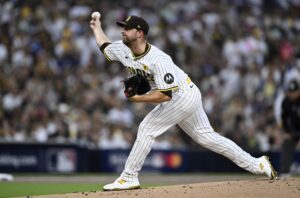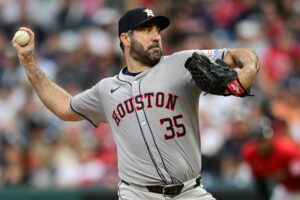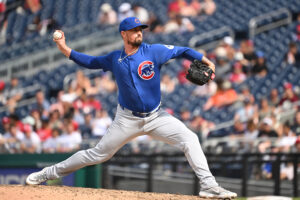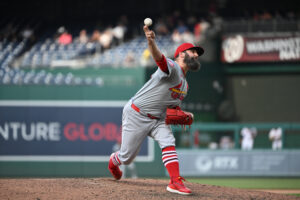While it has not been a great week for the Washington Nationals at the major league level, losing five out of their last six, fans could seek solace with the performance of top prospect Cade Cavalli to begin the minor league season. Cavalli is one of two Nationals prospects on the MLB.com top 100 prospects list, with the other being Jackson Rutledge, who hasn’t pitched since May 21st due to shoulder discomfort.
Wilmington never put Jackson Rutledge on the IL, but he still has not pitched again in a game since experiencing shoulder discomfort a week ago. He last pitched May 21, when he threw just 1/3 of an inning.
— Todd Dybas (@Todd_Dybas) May 29, 2021
With Cavalli, the Nationals may have their first blue-chip pitching prospect since 2016, where they had three top 100 pitching prospects: Lucas Giolito, Reynaldo Lopez, and Erick Fedde.
Cade Cavalli’s Excellent Potential in the Washington Nationals Farm System
Dominant Start to 2021
After not pitching professionally last season, Cade Cavalli is off to an unbelievable start in 2021. He has started five games, posting four quality starts. In 27 2/3 innings, Cavalli has struck out a whopping 45 batters, which is 14.6 per nine innings. Both of these marks are the best in the minor leagues. He also has a 1.63 ERA with a minuscule 0.976 WHIP and has yet to allow a home run this season.
It is not so much the statistics with Cavalli but the way he is pitching. One of the biggest concerns with Cavalli heading into the draft was his fastball command and consistency with his breaking pitches. He has always had the major-league fastball velocity, at 94-98 miles per hour, but getting in the strike zone was an issue in the past. In 2019, Cavalli had 35 walks in 60 1/3 innings pitched. In his junior season, Cavalli gained solid command of the fastball in the strike zone, but had a tendency to stay up in the zone and hang his breaking pitchers, leading to a higher contact and hard-hit rate. However, he has avoided these struggles at Wilmington. He has issued eight walks in 27 2/3 innings, while surrendering 6.2 hits per nine innings.
The sample size is small for Cavalli, especially at the High-A level. But, he has displayed the improvements that many scouts had questions about coming out of Oklahoma. The raw stuff is there for Cavalli to be a piece of the Nationals rotation moving forward, with the mid-90s fastball, a wipeout horizontal slider, and a growing 12-6 curveball with a different plane of movement.
High Upside Coming out of the Draft after a Late Transition
There were many questions coming out of the draft for the Tulsa native, including durability, command, and deception, but the upside was never one of them. He struggled in college with pure production as he initially began as a two-way player at Oklahoma. In his sophomore season, Cavalli batted .319 with four home runs with the Sooners, securing First Team All-Big 12 honors. Next season, Cavalli converted to a pitcher full-time. With his junior season cut short, Cavalli never had the opportunity to fully focus on pitching. This could open new bounds for the 22-year-old right-hander.
Mike Rizzo saw Cavalli’s trajectory, containing untapped potential, as he spoke highly of Cavalli after the draft, “all of the make-up work that we’ve done on him points to a guy that’s a high-character guy, with really good stuff, and just we feel is on the cusp of really taking the next step and doing something big.”
Questions Moving Forward in the Rotation
Currently, the Nationals have one of the deeper starting rotations in the major leagues. With Max Scherzer, Stephen Strasburg, and Patrick Corbin manning the top three and Jon Lester, Joe Ross, and Fedde on the backend, they have six relatively reliable options. Paolo Espino has also been a nice surprise for Davey Martinez after Austin Voth moved to a traditional relief role.
However, Max Scherzer will be a free agent next year. Although fans would love for him to remain in Washington, there are legitimate questions about his future. Joe Ross will also be an unrestricted free agent next year.
With this in mind, Cavalli could be the next in line for Washington if an injury arises next year as Washington has been aggressive with prospects in recent years with Juan Soto and Luis Garcia.
A Big Picture Look at the Farm System
The Nationals farm system as a whole is considered one of the thinnest in the major leagues. Their first-round picks from 2017 and 2018, Seth Romero and Mason Denaburg, have battled injuries thus far, and 2016 first-round pick Dane Dunning was part of the trio of pitching prospects exchanged for Adam Eaton in 2016. Carter Kieboom and Luis Garcia have both graduated the prospect ranks after major league stints. They also traded Jesus Luzardo to the Oakland Athletics in exchange for Sean Doolittle.
But the Nationals are beginning to rebuild this depleted system with Cavalli, Rutledge, and Cole Henry. Henry was a second-round selection in 2020 and has 35 strikeouts in 24 innings pitched thus far. Yasel Antuna is their top positional prospect. Antuna is batting .063 thus far, but he still has legitimate potential as a highly-touted international signing.
While it may not reflect the rankings at this point, the Nationals farm system, led by Cade Cavalli, is looking more and more like the past.
Main Photo:
Embed from Getty Images
Players mentioned:
Cade Cavalli, Jackson Rutledge, Lucas Giolito, Reynaldo Lopez, Erick Fedde, Max Scherzer, Stephen Strasburg, Patrick Corbin, Jon Lester, Joe Ross, Paolo Espino, Austin Voth, Juan Soto, Luis Garcia, Seth Romero, Dane Dunning, Adam Eaton, Carter Kieboom, Jesus Luzardo, Sean Doolittle, Cole Henry, Yasel Antuna






